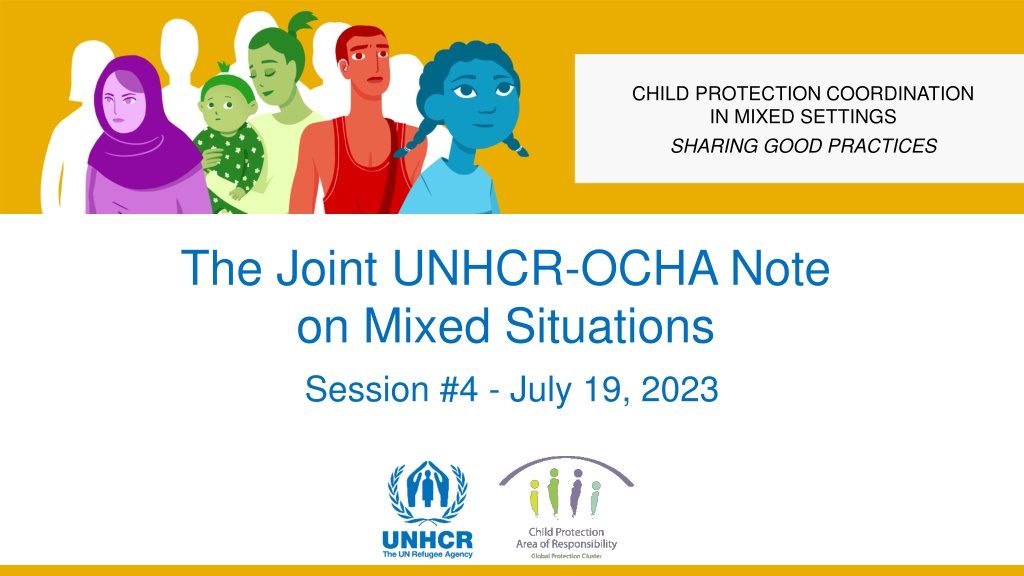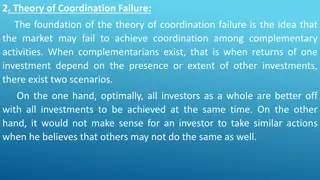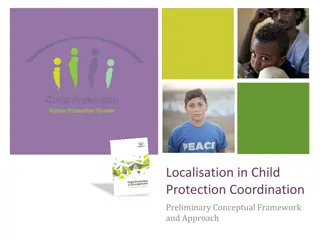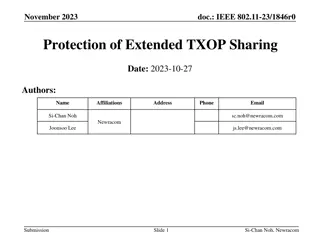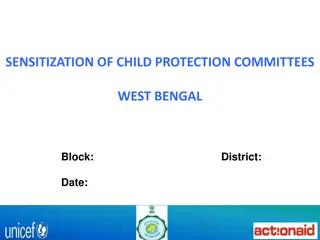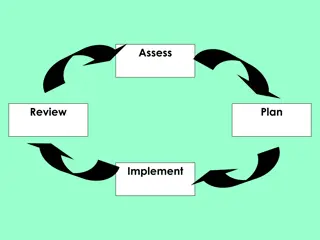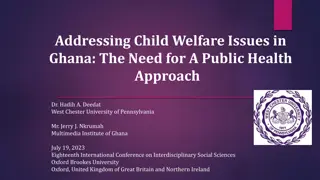CHILD PROTECTION COORDINATION IN MIXED SETTINGS SHARING GOOD PRACTICES
Explore the effective coordination mechanisms and best practices for child protection in mixed settings involving refugees, internally displaced populations, and other affected groups. Topics include similarities, differences, system strengthening, rights-based approaches, coordination responsibilities, and engagement with authorities.
Download Presentation

Please find below an Image/Link to download the presentation.
The content on the website is provided AS IS for your information and personal use only. It may not be sold, licensed, or shared on other websites without obtaining consent from the author. Download presentation by click this link. If you encounter any issues during the download, it is possible that the publisher has removed the file from their server.
E N D
Presentation Transcript
CHILD PROTECTION COORDINATION IN MIXED SETTINGS SHARING GOOD PRACTICES The Joint UNHCR-OCHA Note The Joint UNHCR-OCHA Note on Mixed Situations on Mixed Situations Session #4 - July 19, 2023
Recap: What we know so far SIMILARITIES DIFFERENCES CP systems strengthening In support of Governments Attention to most affected groups Rights based approach A structured approach to coordination Coordination responsibilities Accountabilities Implications of legal status Engagement with authorities Activation / transitioning
Todays Topics Coordination in mixed situations The Joint UNHCR-OCHA Note on Mixed Situations what, where and how The six primary points of interface
Quick Poll How do you feel about the Joint UNHCR- OCHA Note on Mixed Situations? A. I have read it and it s clear to me B. I have read it and it is to some extent clear C. It is not clear / it is confusing D. I didn t read it (yet!)
Mixed settings Internally Displaced Populations Refugee Populations Other Epidemics
What is a mixed setting? Where refugees are present in the country in a separate geographic area from IDPs and other affected population Where refugees are present in the same geographic area as IDPs and other affected population
WHY Ensure that coordination is streamlined, complementary and mutually reinforcing, and to avoid duplication at the delivery level. Sets out the respective accountabilities, roles and responsibilities of the Humanitarian Coordinator and UNHCR Representative in contributing to IASC agreed strategic outputs of coordination. Clarifies the leadership and coordination arrangements. WHERE A Humanitarian Coordinator has been appointed to lead and coordinate humanitarian action and where refugees are present in a separate geographic area from IDPs and other affected populations; A Humanitarian Coordinator has been appointed to lead and coordinate humanitarian action and where refugees are present in the same geographic area as IDPs and other affected populations. WHO The High Commissioner/UNHCR Representative and the Emergency Relief Coordinator/Humanitarian Coordinator will consult and reach mutual agreement on the best option. Regardless of which mechanism (i.e. IASC Clusters or UNHCR Sectors) is utilised, the respective accountabilities of the Humanitarian Coordinator and the UNHCR Representative remain unchanged.
Joint UNHCR / OCHA Note on Mixed Situations Coordination in practice Leadership Strategic planning Delivery Collective outputs of coordination Advocacy Resource mobilisation Operational coordination
Collective outputs of coordination Sharedsituational analysis and understanding Common vision for the humanitarian response Common advocacy messages System-wide resource mobilisation and allocation of pooled funds
Leadership Humanitarian Coordinator UNHCR Representative Leads the provision of international protection, assistance and solutions for refugees, including in complex emergencies. Contributes to the collective HCT outputs &: Shares situational analysis of refugee situation Ensures a common vision and strategic refugee response plan Supervisory responsibility and advocacy for protection/assistance/solutions for refugees Leads the humanitarian coordination in complex emergency and disasters. Facilitates the collective outputs: Shared situational analysis and understanding Common vision for the humanitarian response Common advocacy messages System-wide resource mobilisation and allocation of pooled funds
Strategic planning UNHCR Representative Humanitarian Coordinator Contributes to HRP and ensures leadership and representation of UNHCR led clusters. Leads refugee preparedness and response planning. Ensures Refugee Response Plan it is an integral yet distinct part of the HRP. Coordinates with Humanitarian Coordinator and the HCT on refugee matters. Develops the Humanitarian Response Plan (HRP) based on identified needs in the HNO. Monitors and adjusts humanitarian response.
OCHA/UNHCR Technical Note on HRP Refugee Chapter and the Online Projects Module Source: https://reliefweb.int/report/world/ochaunhcr-technical-note-hrp- refugee-chapter-and-online-projects-module
Operational Coordination and Delivery In same locations within the same country In different locations within the same country
Operational Coordination In different locations within the same country In same locations within the same country AND OR IASC clusters coordinate the response for IDPs and other affected groups (excluding refugees). UNHCR sectors coordinate the response for refugees. The inter cluster coordinator and the UNHCR refugee coordinator share information and ensure mutually reinforcing approaches. Where IASC clusters are used, a refugee expert will work within each cluster. They share information at the national level.
Delivery In same locations within the same country In different locations within the same country AND OR IASC clusters facilitate service delivery for IDPs and other affected groups (excluding refugees). Either IASC Cluster or UNHCR Sectors will be utilised based on the HC and UNHCR Representative agreement UNHCR sectors deliver protection and assistance for refugees and host community. Where IASC clusters are utilised to deliver assistance to refugees, UNHCR delivers protection services to refugees through its protection working group and advocates for the needs of refugees. Where UNHCR sectors are utilised to deliver assistance to IDPs and other affected populations,the accountability of the HC for IDPs and other populations is maintained.
Resource mobilisation UNHCR Representative Humanitarian Coordinator Leads resource mobilisation efforts for the Humanitarian Response Plan. Oversees CERF Grant applications. Manages in country pooled funds (if any). Supports strategic information for effective system wide resource mobilisation. Supports the HC with CERF and pooled funds process for refugee projects. Leads inclusive resource mobilisation for all partners involved in the refugee response.
Advocacy Humanitarian Coordinator UNHCR Representative Coordinates the advocacy efforts. On behalf of HCT, leads advocacy and / or promotes humanitarian negotiations. Supports the advocacy of UNHCR on refugee issues and ensure other advocacy efforts are complementary and supportive. Supports advocacy efforts of the HC/HCT and exercises advocacy role as protection cluster lead. Has primary responsibility for advocacy with host government on refugee issues and leads advocacy on refugee issues.
Key messages on the Joint Note Application: Complex emergencies/situations with IDPs, refugees and other affected people in one country or location. Purpose: Clarify coordination arrangements to deliver effectively without duplication based on joint analysis, comparative advantages and capacities. Scope:Country-level. Objectives:Define complementarities, reinforce mutual systems and efforts, and joint efforts in some specified and focused areas. The Joint UNHCR-OCHA Note on Mixed Situationsrestates commitments to fill delivery gaps if needed.
Key messages The Joint UNHCR-OCHA Note on Mixed Situations does NOT: Cover only IDP settings nor only refugee settings. o Change mandates or accountabilities. o Offer a ready-made structure. o Address issues outside of the six areas of collaboration. o Modify the cluster or refugee coordination system. o
The only MUST-READ for this course! The Joint UNHCR-OCHA Note on Mixed Situations Image source: https://www.gocomics.com/calvinandhobbes
Please take 3 minutes to give us your feedback https://forms.office.com/e/Z8BeSTMkt4
Coming up next week (Week 3)? Webinar #5: Information Management for Coordination on July 25th Get ready for next week by watching any webinars you may have missed. If you haven t already done so, you should also carefully read the Joint UNHCR-OCHA Note on Mixed Situations!
